by W.S. Cranshaw and B. Kondratieff* (2/19)
Quick Facts…

Figure 1: Megatibicen dealbatus, a large “dog-day” type of cicada that is expanding populations along the Front Range.. |
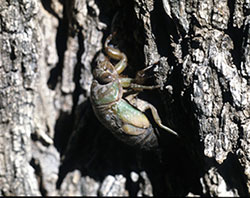
Figure 2: Cicada nymph recently emerged from the soil, preparing to molt to the adult form. |
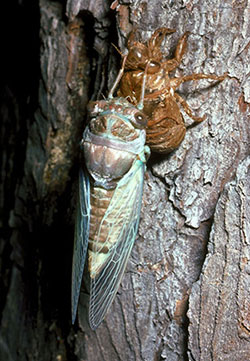
Figure 3: Cicada adult that has recently molted. After molting adult cicadas are initially light colored and soft, but soon darken and harden. The old exoskeleton (“skin”) of the previous stage nymph is underneath. Photograph courtesy of Herbert A. Joe Pase III. Texas Forest Service and Bugwood.org. |
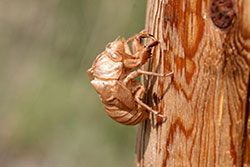
Figure 4: The old “skin” of a last stage cicada nymph, after the adult stage has emerged. |
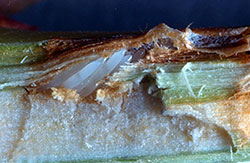
Figure 5: Eggs of a cicada inserted into a twig. Photograph courtesy of The Ken Gray Collection, Oregon State University. |
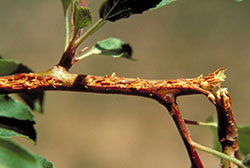
Figure 6: Twig injured by egg laying by a cicada. Twigs are weakened by these oviposition wounds and may easily break. Photograph courtesy of David Leatherman. |
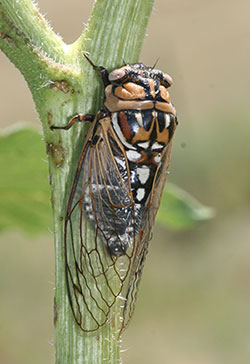
Figure 7: Megatibicen dorsatus, the giant grasslands cicada. |
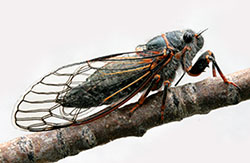
Figure 8: Putnam’s cicada. Photograph courtesy of David Leatherman. |
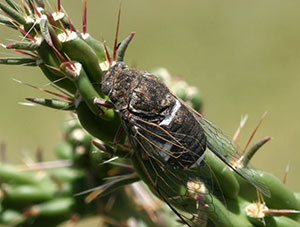
Figure 9: Cactus dodger. |

Figure 10: Okanagana bella, the mountain cicada. |
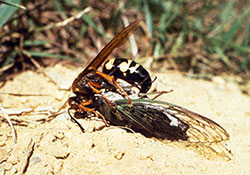
Figure 11: A cicada killer wasp with prey. Photograph courtesy of Howard Ensign Evans. |
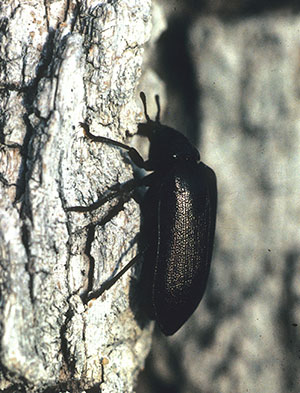
Figure 12: Sandalus niger, a parasite of cicada nymphs. |
- Cicadas are large insects with young stages that burrow and develop underground and feed on fluids from roots of grasses, shrubs, and trees.
- The adult cicadas found in Colorado emerge 3 to 5 years, sometimes longer, after eggs have hatched.
- Periodical cicadas, such as the 17-year and 13-year cicadas, do not occur in Colorado.
- Male cicadas “sing” to attract females. Many produce loud, shrill buzzing noises.
- Cicadas do little if any injury while feeding on plants. Female cicadas sometimes cause injury when they insert eggs into twigs, producing wound pockets that may weaken smaller branches and cause them to break.
Cicadas are among the largest Colorado insects in the order Hemiptera, which includes other sap-sucking groups with prominent beaks such as leafhoppers, aphids, and spittlebugs. Twenty-nine species occur in the state (Table 1). The largest (Megatibicen spp.) are stout-bodied insects that are 1 to 1 ½ inches but Colorado’s cicadas range considerably in size. Beameria venosa, Cicadettana calliope and C. kansa are small species (ca. ½ inch) that is develop on grasses and shrubs growing in hillsides of canyons and arroyos of both eastern and western Colorado.
Although abundant, cicadas are far more often heard than seen. Males make a variety of sounds to attract females. Most commonly heard are loud, often shrill, buzzing calls, sometimes with several individual insects synchronizing their songs. Other cicadas make rustling or clicking noises.
Despite their large size, cicadas cause little injury. The immature stages (nymphs) burrow in the soil and insert their beaks into roots and feed on plant fluids but develop slowly causing no detectable harm to the plants. The greatest injury occurs when large numbers of certain cicadas, such as the Putnam’s cicada, insert eggs into stems of trees and shrubs (oviposition injury). This egg laying injury can cause some twig dieback or weaken smaller branches that can snap off during wind. This type of damage is known as flagging.
Cicadas are sometimes called locusts. This is incorrect, as locust is a term properly used to describe very different insects – certain grasshoppers (order Orthoptera) that occur in large migratory bands or flights.
Life History and Habits
Cicada nymphs develop underground, feeding on fluids they suck from the roots of grasses, shrubs, and trees. The nymphs are generally pale brown, rather hunch-backed, and have stout forelegs they use to dig through soil.
When full-grown, nymphs emerge from the soil. They crawl up a nearby plant or wall, and the nymphal exoskeleton (“skin” or exuvia) splits along the back. The adult form then emerges, pulling themselves from the old skin. The new adult will then hang for several hours, while blood is pumped to extend the wings. The new exoskeleton hardens and darkens rapidly, and the adult cicada then flies away, leaving behind the discarded nymphal skin.
In most species, only male cicadas “sing”, which is done primarily to attract females by their characteristic songs. Most cicadas produce sound using a structure known as a tymbal located on the abdomen of the insect. The tymbal can produce high frequency clicking that resonates within chambers of the body. Very loud songs can be produced in this manner. Some cicadas, such as the Putnam’s cicada, lack tymbals and produce soft rustling songs using their wings. In these species, females also can make return calls.
Adult cicadas normally will live about four to six weeks after they emerge from the soil. This length of time can vary with weather conditions. After mating, the adult females lay their eggs which they insert into stems of plants. Egg laying punctures produce some plant wounding (oviposition wounds) and may cause damaged twigs to break and die (“flagging”). A few weeks after eggs are laid, nymphs hatch from the eggs, drop to the ground, burrow into the soil and move to roots on which they feed.
The life cycles of Colorado’s cicadas take years to complete and they are among the longest lived of all insects. Most probably require 3-5 years to develop, but some may live as long as 8 years. In all cases the great majority of a cicada’s life takes place underground.
Periodical cicadas, (Magicicada species), such as the 17-year and 13-year cicadas, are even longer lived. Periodical cicadas emerge during synchronized periods, often in spectacular numbers, every 17th or 13th year, respectively. Periodical cicadas are largely restricted to areas east of the Mississippi River and do not occur in Colorado.
Some Commonly Observed Colorado Cicadas
Megatibicen species (“dog-day cicadas”) are the largest and among the loudest of the Colorado cicadas, producing loud droning buzz that during midsummer into the fall. Three species occur but Megatibicen dealbatus (plains harvest-fly) is the most common. Native to forested areas along waterways in southeastern Colorado, it has adapted well to urban forest landscapes and has been extending its range northward through much of the Front Range. Occasionally, M. dorsatus (giant grasslands cicada) can be heard calling from fence posts or grassland shrubs throughout eastern Colorado and including some open space grassland areas along the Front Range.
Platypedia putnami (Putnam’s cicada) is one of the most common species statewide, it can be particularly abundant in shrublands of Gambel oak or mountain mahogany in foothills areas but has moved into irrigated landscapes of some urban areas along the Front Range. Noticeable plant wounding during egg laying has been noted with this cicada, occurring on plants such as maple, crabapple, and honeylocust. Males lack tymbal organs and instead communicate with songs produced striking their wings together making producing a soft rustling click, similar to that produced by striking together two coins. This is the clicking sound that is often heard in the trees and shrubs in the spring into early summer. (In late summer and early autumn, a common clicking sound is produced by a different insect, Microcentrum rhombifolium, known as the broadwinged or greater anglewing katydid).
Cacama valvata (cactus dodger) is large gray/black species often associated with tree cholla cacti (Cylindropuntia) that grow in southeastern Colorado, and other shrubs in southwestern Colorado. When disturbed they can make a shrill, ear-splitting call that is the loudest produced by any of the Colorado cicadas.
Okanagana bella (mountain cicada) is a black and red species that somewhat resembles a large Putnam’s cicada. It occurs in where aspen grows intermixed with conifers. Males make a long, shrill song that often lasts one to two minutes.
Natural Enemies of Cicadas
Cicadas have several natural enemies, many with unusual habits. Perhaps most spectacular are the cicada killer wasps (Sphecius species) of southeastern and southwestern Colorado that somewhat resemble enormous yellowjacket wasps. Cicada killers capture and paralyze adult cicadas of large species, such as the “dog-day” cicadas. The wasps dig nest cells a foot or more underground and return with the cicada prey to provide food for their young. Another insect enemy found in eastern Colorado is the cedar beetle, Sandalus niger. These develop as parasites of cicada nymphs. Several kinds of birds will also feed on cicadas. The Mississippi kite, a large predatory bird normally found along the Gulf Coast, has expanded its summer range into the Arkansas Valley, where it subsists almost entirely on cicadas.
Additional Reference
Insects of Western North America. 2. The Cicadas of Colorado (Homoptera: Cicadidae, Tibicinidae). 2002. Kondratieff, B.C. A.R. Ellingson, D.A. Leatherman. Contributions to the C.P. Gillette Museum of Arthropod Diversity. Colorado State University. 81 pp.
Table 1. Checklist of Cicadas Known from Colorado
Cacama valvata (cactus dodger)
Diceroprocta apache
Diceroprocta eugraphica
Megatibicen dealbatus (plains arvest-fly)
Megatibicen dorsatus (giant grasslands cicada)
Megatibicen tremulus
Hadoa bifida
Hadoa duryi
Hadoa inaudita
Neotibicen pruinosus
Beameria venosa
Pacarina shoemakeri
Okanagana bella (mountain cicada)
Okanagana canadensis
Okanagana funipennis
Okanagana gibbera
Okanagana hesperia
Okanagana magnifica
Okanagana occidentalis
Okanagana schaefferi
Okanagana striatipes
Okanagana synodica
Okanagana utahensis
Cicadettana calliope
Cicadettana kansa
Platypedia minor
Platypedia mohavensis
Platypedia putnami (Putnam’s cicada)
Neoplatypedia constricta
* W.S. Cranshaw, Colorado State University Extension entomologist and professor, and B. Kondratieff, professor; bioagricultural sciences and pest management. 2/99. Revised 2/19.
Go to top of this page.





